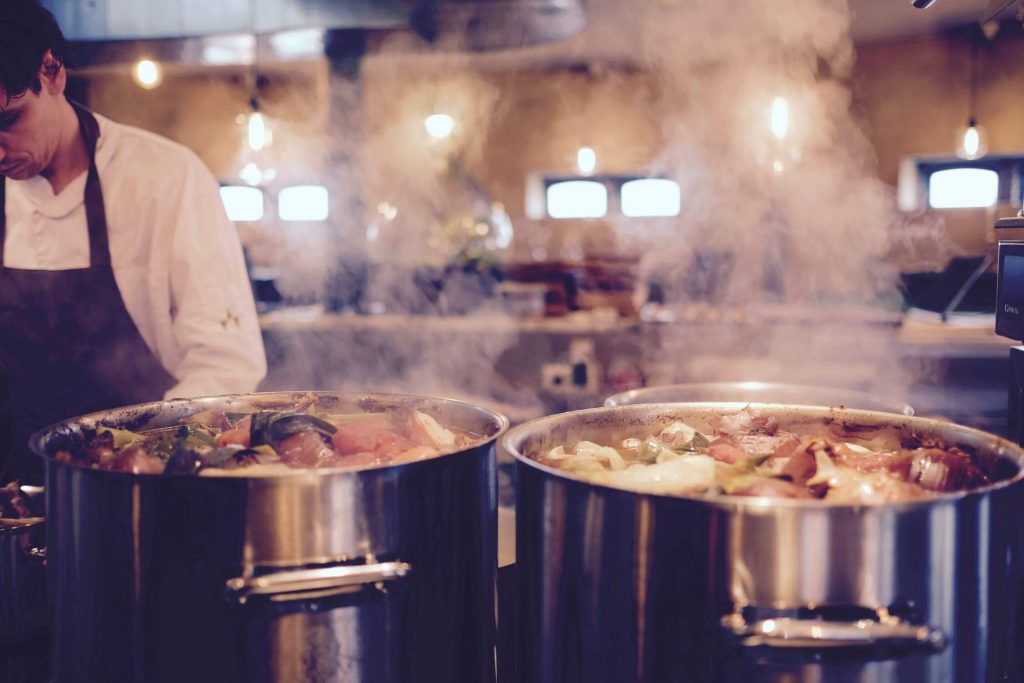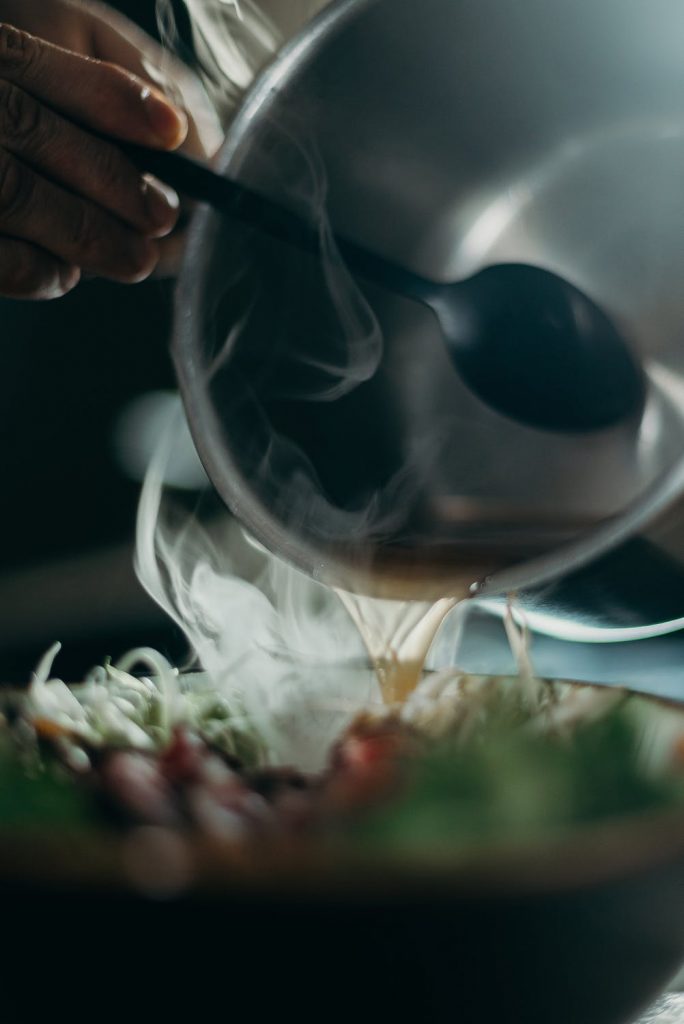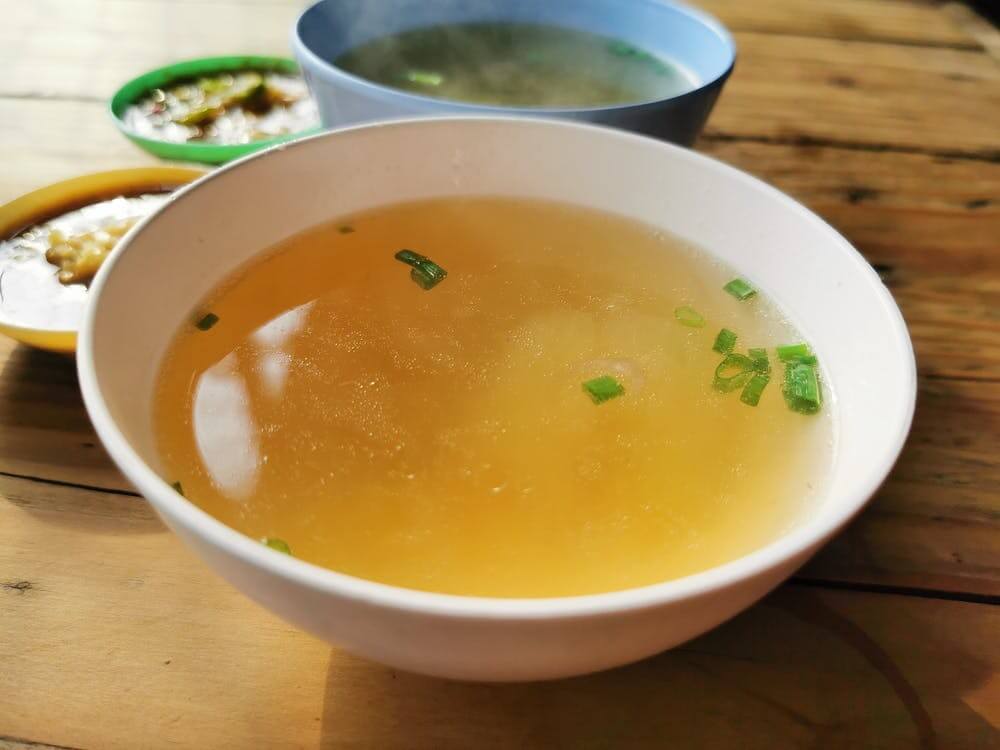When creating bone broth, there is no “correct” type of bone to utilize. However, if you want your broth to gel when it cools, which is a sign that it contains collagen, use a combination of marrow bones, joints, knuckles and even feet. It will give you the most collagen possible in your broth. The highest concentration of gelatin is found in the knucklebones and feet of animals. Common sources of gelatin include chicken feet and pork trotters, both of which are inexpensive. When using animal feet, make sure to blanch any bones you use by following the instructions below.
Fish heads are the best part of the fish to use when making fish stock since they have a refined flavour and are loaded with nutrients. You can cook fish stock in as little as one to four hours. Hence, the recommended simmering times and recipes that follow do not apply. In addition, the fish stock is most effective when prepared using oil-free fish such as halibut, cod, sea bass or flounder, whose flavour won’t be too dominant in the finished product. The pig and beef bones that are easiest to acquire are typically referred to as “scrap” or “soup bones” and are typically sold by the kilogram. Therefore, they are the two ingredients I rely on most frequently while creating broth. On the other hand, if I come across ham bone scraps, I stock up. Ham’s bones are excellent for preparing spaghetti sauce and chunky soups, but they do not result in a broth that has a balanced flavour profile.
On the other hand, using duck bones to make a meat broth results in the best flavour, at least according to my taste buds. However, duck bones are not included in the definition of scrap. Additionally, the cost of a whole duck is high. Therefore, after removing all the meat from a whole duck we purchased for a special occasion, I like to use the bird’s carcass as much as possible. No, I do not use any shrimp, prawns, crabs or any other type of crustacean when making the soup that is based on seafood. I have a sensitivity to all crustaceans. Therefore, whenever I’m in the mood for a broth made with seafood, the first thing that comes to mind is a combination of clams and mussels. However, have you ever attempted to prepare rice by boiling it in a seasoned mussel and clam broth rather than plain water? It is fantastic in every way! You want the very best chicken bone broth, don’t you? No need to look any further! You won’t have any problems using Bone Broth.
The fish heads are what I use to make the fish broth. Therefore, whenever I purchase fish and have the meat of the fish filleted, I bring the heads and bones home with me and utilize them to prepare the fish broth.
What Is Bone Broth?
Foodies will tell you that we currently term broth a sort of stock made by simmering animal bones with some meat attached for more than 12 hours in a pot with a drop of apple cider vinegar or another acid. The result is a liquid high in gelatin and nutrient content. It may be consumed independently or used as a base for a range of delectable soups and stews.
The popularity of bone broth coincides with an increase in autoimmune diseases and other conditions that affect people’s health. Even though there have only been a handful of scientific studies on the curative effects of bone broth, natural health proponents have been singing its praises for over a decade (and your grandmother for longer than that).
It has been hypothesized that drinking bone broth can mend the stomach lining and improve nutritional absorption, restoring overall vigour to those whose digestive systems are compromised. In addition, some people believe it can improve skin issues by supplying the body with healthy collagen and vitamins.
In a study that took place more than a decade ago at the Nebraska Medical Center, researchers discovered that chicken soup made with bones possessed anti-inflammatory qualities, particularly when applied to upper respiratory tract infections. In addition, according to Harvard Health, it is an excellent source of protein, although other claims about it have been called into question.
Other research suggests that individuals who consume bone broth before a meal eat less food throughout that meal, making it an excellent beverage option for those attempting to reduce their body fat percentage. Whatever reason you’re drawn to bone broth, you’ll undoubtedly agree that it has a delicious flavour. On a brisk autumn day, when seasonal colds are going about, a calming combination of broth and veggies can help cleanse the throat and strengthen the spirit.
How Is Bone Broth Different From Stock?
What exactly is the difference between bone broth, broth, and stock? It is a subject that comes up frequently. As a result, we frequently use the terms interchangeably. Nevertheless, despite their similarities, they are not the same.
The consistency of regular broth is similar to that of water. Most of its components are leftover bits of meat or vegetables, which may also contain a few shards of bone here and there. Sometimes, it may contain extra herbs and spices in addition to those already present. However, the cooking time is significantly reduced. Therefore, when you go to the grocery store and find that they are selling vegetable or beef broth, they are most likely selling this.
Bones, ligaments and other connective tissue are simmered in water for around two to four hours to produce the stock. Again, vegetables or herbs and spices are sometimes added at this point.
The extended amount of time the bones are cooked for helps extract healthy chemicals like gelatin and collagen from them. Because of the gelatin, the stock will be significantly more concentrated and flavorful (maybe even becoming like jello when refrigerated).
In many ways, bone broth is more analogous to stock than broth. As with stock, it is made by boiling bones, but the simmering process takes significantly longer. In most cases, the cooking time ranges between 12 and 48 hours. As a result, even more nutrients are released from the bones, including an increased amount of gelatin, which causes it to have a consistency that is significantly more dense than either broth or stock.
What Are The Beneficial Nutrients In Bone Broth?
Everyone will tell you that bone broth is healthy for you, but why? Why do some people refer to it as “liquid gold”, and what specific components does it include that give it that name?
Collagen:
Collagen is the most abundant type of protein in the body, accounting for around 30 per cent of the total protein we have.
It is mostly located in the skin, joints, bones, tendons and ligaments and is responsible for providing our tissue with its structure. It is sometimes referred to as the glue that ties our bodies together for a good reason.
Gelatin:
When collagen is cooked over an extended time, gelatin is produced as a byproduct. Therefore, when chilled, the bone broth will have gelatin consistency due to this ingredient’s presence. Excellent for digestion and highly calming to the gastrointestinal tract!
Amino Acids:
There are 17 different types of amino acids found in bone broth. Amino acids are the fundamental components of proteins found in the body. Amino acids are necessary for a wide variety of bodily processes, including but not limited to the development of muscle and the promotion of wound healing. When we don’t get enough of anything, we can experience problems with our reproductive, immune function, and digestion.
Glycine and proline are two of the amino acids that are found in exceptionally high concentrations in bone broth.
Glycine:
Glycine is a short-chain amino acid with a disproportionately large impact on its size. It is involved in the breakdown of fatty acids in the food we eat, which helps with digestion and is only one of the numerous body functions it assists. Learn more about the benefits of our best bone broth here in Melbourne.
Glycine stimulates the production of serotonin within the body, which has an important role in sleep quality and overall mood.
In addition to this, it assists in the regulation of blood sugar levels and the transport of glucose to cells and other parts of the body. Maintaining a normal blood sugar level is essential for both the health of the brain and one’s energy levels. Additionally, it will assist in preventing chronic issues such as heart disease, neurological disorders and diabetes.
Proline:
One amino acid that is beneficial to one’s health is proline.
When it comes to the process of healing wounds and joints, as well as the formation of collagen and connective tissue, it is an essential component. It also helps to mend the lining of the intestines if injured.
In addition, proline assists in the process of metabolizing food and protects our systems from the damaging effects of oxidative stress and free radicals.
In addition, it helps strengthen and maintain the muscles in the heart, which is beneficial for the heart’s overall health.
There are others, such as glutamine and glycosaminoglycans, but I don’t want to make this a ten-page entry for the encyclopedia, and you have places to be and things to do.
How To Make Bone Broth At Home?
Even though you could dump all of your ingredients into a pot, turn on the heat and call it a day, there are a few easy procedures you should take before you start that will increase the flavour and quality of your bone broth.
Blanch Your Bones
Blanching the bones helps you achieve the clean and clear broth you are presumably going for. In addition, blanching eliminates contaminants from the bones. To prepare the bones for roasting, cover them with cold water in a big saucepan or stockpot and bring the water to a boil. After boiling the water, turn the heat up to high and cook the bones for twenty minutes.
Roast Your Bones
When bones are roasted specifically to make broth, it helps bring out the flavour and capture the depth that will ultimately give your soups and stews a robust, savoury quality. After the bones have been drained, place them in an oven preheated to high (400-450 degrees Fahrenheit) and roast them for at least one hour. The length of time needed to caramelize the bones depends on the size of the bone.
Boil Your Bones
Now pick a strategy, and get to work in the kitchen. Although your recipe can consist of nothing more than bones, water, and maybe a splash of vinegar for good measure, the nutrient density of your broth can be improved by adding fresh herbs and vegetables. Check out the following for some choices.
In A Slow Cooker
Your selected bones should take up roughly half the space in your slow cooker before you pour water to cover them. After that, put in one onion, one entire carrot, one or two celery sticks and a dash of apple cider vinegar. At this point in the process, you can also add any fresh or dried herbs available. Some of the most popular ones are thyme, bay leaves, parsley, rosemary and coriander seeds. Next, add some salt, pepper and other seasonings, then cook on LOW for twenty-four hours. Finally, remove any excess fat that has risen to the top of the dish. After it has slightly cooled, pour it into jars.
In A Pressure Cooker
Because they contain steam and allow food to be cooked at higher temperatures, pressure cookers significantly reduce the time necessary to prepare the bone broth. Therefore, it is a good strategy to use when you’re in a rush or want to save time and effort.
The bones, veggies and herbs listed above should be added to your pressure cooker and enough water to reach the fill line and cover all the bones. Include a few drops of vinegar made from apple cider. Bring to a boil, then continue cooking on high for approximately three hours. Allow the temperature to drop for about 15 minutes so the steam can escape normally. After it has had a chance to cool gently, pour the broth into jars so that you can store it later.
On Your Stovetop
When making bone broth on the stovetop, get an early start, so you have plenty of time to let it boil. Put three to four and a half pounds of bones into a stockpot. Include a dash of apple cider vinegar along with three carrots, three celery stalks and two large onions in the recipe. Prepare using the herbs and spices described up top. After boiling the pot using high heat, drop it to low and let it simmer for 12 hours. Take it off the heat for the night, and then keep returning to it throughout the following days until you’ve reached 24–36 hours of simmering time.
Pressure Cooker Vs. Slow Cooker Vs. Stovetop
I do not own a pressure cooker, and as a general rule, I am sceptical of any recipe or technique that calls for using a particular gadget. However, you can greatly reduce the cooking time for this dish by using the kitchen mentioned above gadget, which also results in a significantly higher quality end product.
Cooking under high pressure. After being subjected to high-pressure cooking for two and a half hours, the bones had completed most of their function. The cartilage surrounding the bones had become pliable, but the bones themselves had not yet begun to disintegrate. The disintegration of the bones is a reliable indicator that the broth will be rich in gelatin and have a complete flavour profile. After an additional hour and a half of being subjected to high pressure, the cartilage finally disintegrated entirely, and certain regions of the bones eventually became pliable. It is in everyone’s best interest to let the pressure cooker depressurize on its own, given the big (read: maximal) volume of meaty and fatty liquid that is contained within the pot (I did this manually the first time and got hot bone broth all over my countertop and walls).
Cooking on low heat. Unfortuitously, a slow cooker will not reach a high temperature enough to break down bones adequately, nor will the use of a slow cooker reduce the amount of time needed to cook the food in any meaningful way. If you’re going to do it, you might as well do it on the stove, in my opinion.
Stovetop. It was doable. However, it took the cooktop method 16 hours to get to the same bone-melting point as the slow cooker method. I’m not crazy about leaving the stove on for that extended time (overnight, especially). However, the stovetop method is the one that will yield the greatest results if you intend to spend the entire day in or around the house and take pleasure in the aroma of beef cooking in the air. Are you looking for recipes for bone broth? No need to look any further! You won’t have any problems using Bone Broth.
Allow the stock to come to room temperature before passing it through a fine strainer and transferring it to smaller sealed containers. I find that quart containers and Mason jars are the easiest to label, put away, and take out of the freezer when I need them. For this reason, I favour using them. If you are going to fill the containers with liquid, make sure to leave at least one and a half inches of headroom. Because liquids expand as they freeze, your jars are more likely to crack (this is how I damaged at least five jars). After only a few hours in the refrigerator, the stock should harden, and the “puck” of fat that has risen to the top should be very easy to remove. Don’t just throw this away! Keep the rendered beef fat, also known as tallow, in a jar so you can later use it to roast root vegetables in the winter, toast slices of bread or crisp mashed potatoes.


